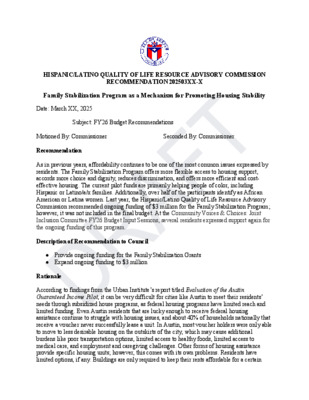Item #4 Draft Budget Recommendation - Family Stabilization — original pdf
Backup

HISPANIC/LATINO QUALITY OF LIFE RESOURCE ADVISORY COMMISSION RECOMMENDATION 202503XX-X Family Stabilization Program as a Mechanism for Promoting Housing Stability Date: March XX, 2025 Subject: FY26 Budget Recommendations Seconded By: Commissioner Motioned By: Commissioner Recommendation As in previous years, affordability continues to be one of the most common issues expressed by residents. The Family Stabilization Program offers more flexible access to housing support, accords more choice and dignity, reduces discrimination, and offers more efficient and cost- effective housing. The current pilot funds are primarily helping people of color, including Hispanic or Latino/a/x families. Additionally, over half of the participants identify as African American or Latina women. Last year, the Hispanic/Latino Quality of Life Resource Advisory Commission recommended ongoing funding of $3 million for the Family Stabilization Program; however, it was not included in the final budget. At the Community Voices & Choices: Joint Inclusion Committee FY26 Budget Input Sessions, several residents expressed support again for the ongoing funding of this program. Description of Recommendation to Council ● Provide ongoing funding for the Family Stabilization Grants ● Expand ongoing funding to $3 million Rationale According to findings from the Urban Institute’s report titled Evaluation of the Austin Guaranteed Income Pilot, it can be very difficult for cities like Austin to meet their residents’ needs through subsidized house programs, as federal housing programs have limited reach and limited funding. Even Austin residents that are lucky enough to receive federal housing assistance continue to struggle with housing issues, and about 40% of households nationally that receive a voucher never successfully lease a unit. In Austin, most voucher holders were only able to move to less desirable housing on the outskirts of the city, which may cause additional burdens like poor transportation options, limited access to healthy foods, limited access to medical care, and employment and caregiving challenges. Other forms of housing assistance provide specific housing units; however, this comes with its own problems. Residents have limited options, if any. Buildings are only required to keep their rents affordable for a certain period of time, and then they can increase rent. The units are set up to be affordable based on the area median income (AMI), and they do not provide the deep affordability that residents need. According to the report, “Austin’s local affordable housing inventory lists six times the number of units with rents set to be affordable at 80 percent of AMI as units with rents set to be affordable at 30 percent of AMI.” Additionally, these units offer set rental prices, and the person is still responsible for paying the full rent even if they experience job insecurity. According to findings from a brief from the Urban Institute titled Guaranteed Income as a Mechanism for Promoting Housing Stability, unrestricted cash investment addresses gaps and deficits in policies designed to address America’s housing affordability crisis. The brief reported, “Insights from a research review and policymaker interviews suggest that strategically applied cash relief could accomplish the following: 1. Offer renters facing one-time or intermittent housing shocks more flexible access to housing support. 2. Accord more choice and dignity to any renter in need of housing support. 3. Reduce exposure to voucher discrimination and offer more housing choices to marginalized populations. 4. Provide increased housing access to excluded workers. 5. Offer more efficient and cost-effective housing help to those in urgent need now.” According to findings from the Urban Institute’s report titled Evaluation of the Austin Guaranteed Income Pilot, participants reported spending, on average, more than 50% of their pilot cash to cover housing costs, and the average share participants spent on housing was more than twice as much spending in any other category. Improved housing security allowed for participants to also focus on other goals, including financial investing, skills building, expanding their professional networks, and pursuing additional education. Overall, median household incomes increased over time: Information from the Urban Institute’s report titled Evaluation of the Austin Guaranteed Income Pilot includes demographic information for those in the pilot: Additionally, information was broken down by Council District and Zip Code: The Fiscal Year 25 budget allocated one-time funding of $1.3 million to the Family Stabilization Grant Program. The current funding level is inadequate to meet the needs of the community. For example, one of the organizations, BASTA, received 200 applications. After determining eligibility, BASTA used a lottery system to select the 5% of participants who were enrolled. The City of Austin and Austin City Council continue to recognize the benefits the Family Stabilization Program has on individuals and the community as a whole. Therefore, ongoing funding of $3 million should be included in the budget. Vote For: Against: Abstain: Absent: Attest: Urban Institute Guaranteed Income as a Mechanism for Promoting Housing Stability - https://www.urban.org/sites/default/files/2022- 12/Guaranteed%20Income%20as%20a%20Mechanism%20for%20Promoting%20Housing%20Stability.p df Urban Institute Evaluation of the Austin Guaranteed Income Pilot - https://www.urban.org/research/publication/evaluation-austin-guaranteed-income-pilot